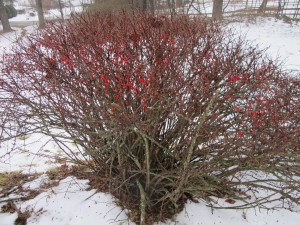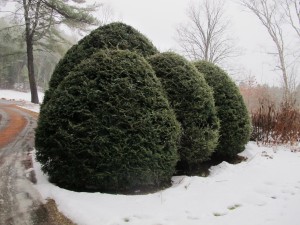Consider the Birds
Even Ebenezer Scrooge, (at least in his post-enlightenment days) probably had a bird feeder. Virtually everyone I know does, at any rate. Why? Because live birds are fun to watch, colorful, and because we pity them on cold mornings. Ten below zero? Those little chickadees are puffed up and fat-looking, increasing their tolerance to the cold by fluffing up their feathers. They seem to rely on us for food, but in fact, what we provide is more like dessert.
According to some studies, in winter birds only get about 25% of their calories from seed we buy. Maybe less. All year long they eat seeds, bugs, berries, nuts and all sorts of scavenged food. But we can help them by planting shrubs and trees that provide high calorie, nutritious food. Which is to say we shouldn’t be planting Fruit Loops – or the equivalent – we should be planting native species that are the equivalent of oatmeal or other healthy foods.
If you wish to plan on planting some bird-friendly plants, there is a wonderful book to help you: Richard DeGraaf’s Trees, Shrubs and Vines for Attracting Birds (University Press of New England, 2nd edition 2002, paper). It lists more than 160 woody plants used by birds and lists the birds that use each for food, cover or nesting.
A friend of mine has a barberry hedge and since barberries are on the invasive species list, I’d love to see the backhoe come next spring to pull those prickly shrubs out by their roots. I see barberries throughout the woods and at the edges of the fields – planted by the birds, and taking over the understory.
So what would I substitute as a hedge? Looking though DeGraaf’s book, I see plenty of shrubs that would serve the birds better. Common barberry (Berberis vulgaris) is eaten by just 7 species of birds. Highbush blueberry, on the other hand, is eaten by 52 species of birds, according to his book. But some might note that barberries persist during the winter (they are not very palatable to most birds), so they can serve as emergency rations.
But there are native species that also have berries that persist for most of the winter, but will not take over the undergrowth and squeeze out other species. There are plenty of viburnums that have good berries, some of which persist into winter. Viburnums, in general, are fast growing shrubs with nice flowers and berries. I particularly like one called Viburnum sargentii ‘Onodaga’ that has spectacular clusters of white blossoms in early summer. On the downside, however, there is an insect pest a beetle – that is killing or damaging some viburnums, so check at your family-owned, local nursery to find which species are susceptible to the beetle before buying.
And there is of course, the common cranberrybush viburnum (V. opulus) which produce masses or red berries that persist into winter. DeGraaf’s book lists 31 birds that eat the berries, including several thrushes, bluebirds, catbirds, bluejays, flickers and flycatchers. Definitely a better hedge than barberry.
Our native dogwoods of various sorts are attractive to birds, and some are fast-growing and suitable to use as hedges. Redosier dogwood (Cornus sericea) does best in wet spots, but will grow in ordinary garden soil, too. It spreads by root, so it will fill in to form a hedge in no time. The bright red (or yellow) stems of new growth can be spectacular for winter viewing. Some 20 species of birds eat the fruit.
Full sized trees are important to birds, too. They can provide shelter, nesting sites and food. Two common evergreens are among the best: white pine and Canadian hemlock. White pines provide food for 46 species of birds, and almost as many use them for nesting and cover. They are easy to grow and tough – just keep them well away from salted roads, as salt can kill them.
Canadian hemlock is the preferred nesting site for robins, blue jays and wood thrushes, among others. The seeds are good winter food for juncos, chickadees, goldfinches, blue jays and others. And unlike pines, one can use them to create hedges. That said, many people start out using hemlocks for hedges, only to get lazy for a few years – and discover that their hedge is 12 feet tall! That’s delightful to the birds, but may not give you the size hedge you wanted.
Apples, crabapples and nut trees are good for birds, too. Not all crabapples appeal to birds, but some favorites include Snowdrift, Sugar Time, Indian Magic, Sargent, Red Jewel, Prairie Fire and Golden Rainbow. Even hard nuts are helpful – often after squirrels finish with them there are tasty tidbits left in the shells for birds.
Almost anything you plant will provide something for the birds, but do your homework this winter to see what would please both you and the birds.
Henry Homeyer can be reached at henry.homeyer@comcast.net. His web site is www.Gardening-guy.com. He is the author of 4 gardening books.




